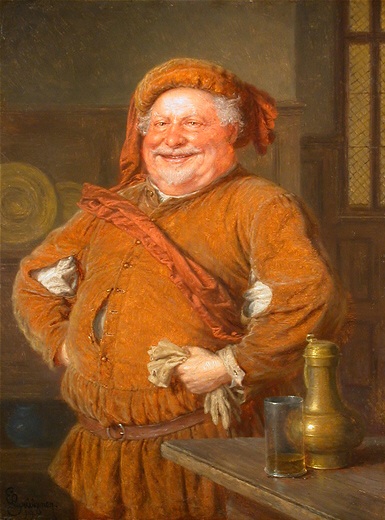
One of true beer drinkers’ heroes! “Sir John Falstaff” with a pewter serving stein and glass beaker, most often shown in his hands.
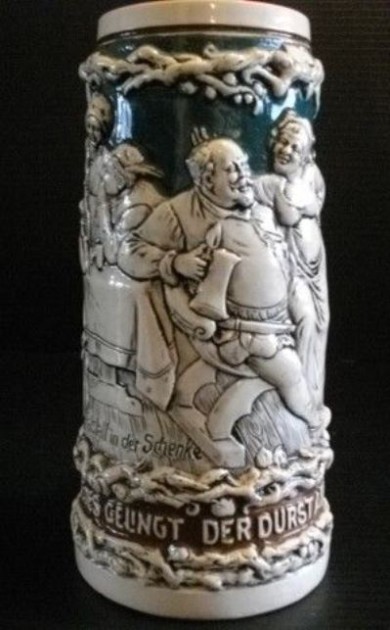
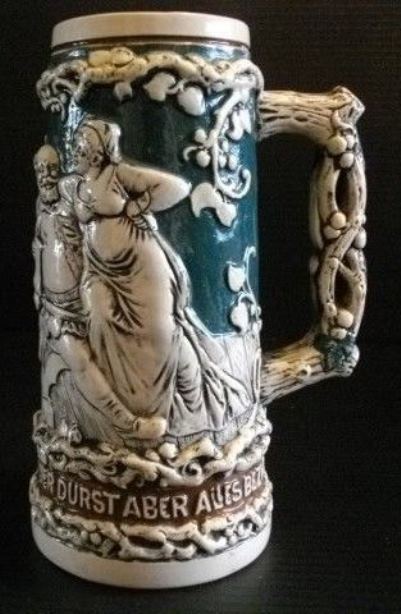
The old knight Falstaff with Miss Quickley, drinking from a German pewter beer server!
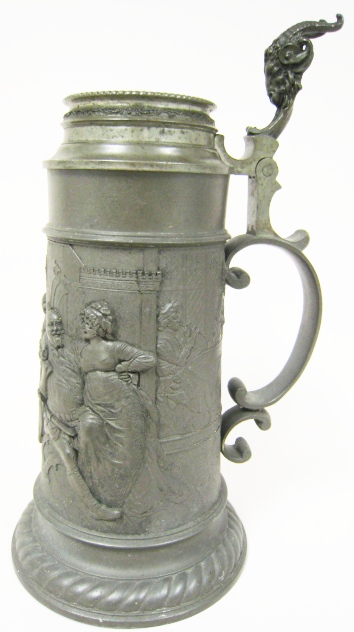
The same scene as shown on the print above, on a 1.5 liter pewter made stein by F & N, M.
.
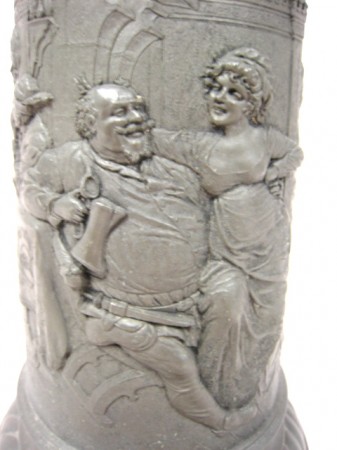
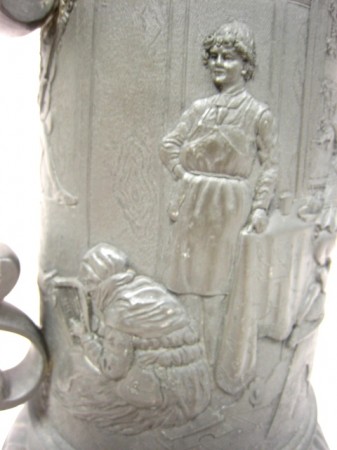
.
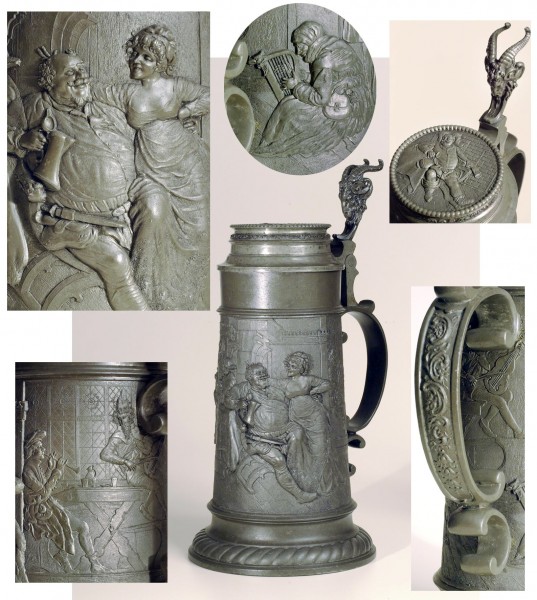
Details of the great relief work on this stein.
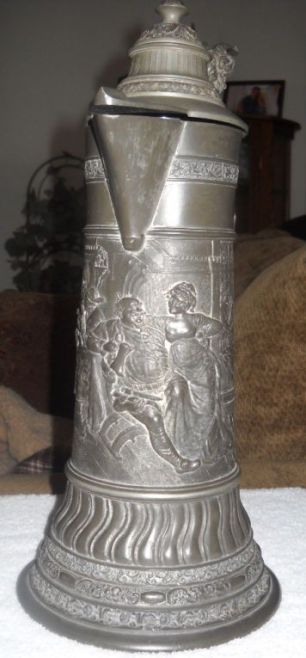
The same relief scene but on a taller beer server ▲, and on an oversized (1.5 liter) stein below▼. Both by F & N, M.
.
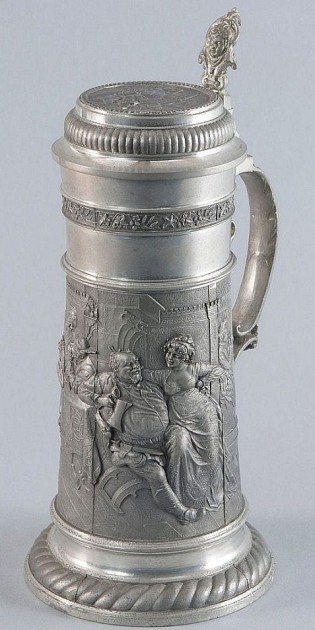
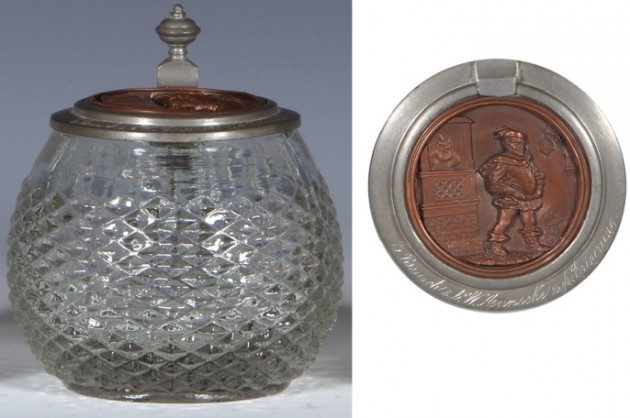
Falstaff on a “Bronzed” (not bronze) lid on a “Hob nail” mold blown glass stein. Ca, 1885. [tsaco]
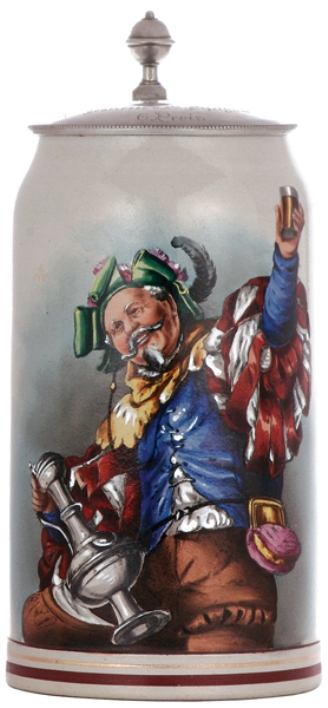
A hand painted scene of Sir John on a two liter stoneware stein Circa 1890. [TSACO] Notice the pewter renaissance flagon he is carrying.
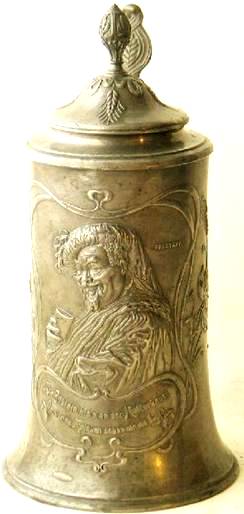
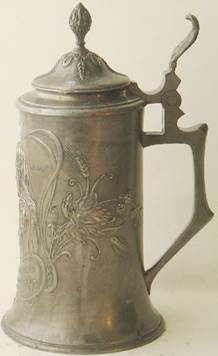
Art Nouveau pewter relief stein. 8.5 inch, -.5 liter. Circa 1910. [S A.]
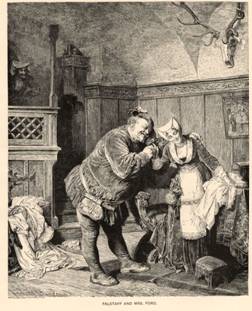
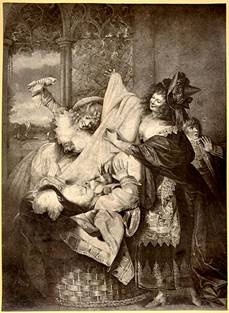
Two unknown artist’s versions of Sir John Falstaff with Mrs. Ford.
Sir John Falstaff is a fictional character who appears in three plays by William Shakespeare. Round and glorious, tradition holds that Shakespeare wrote the part for his second comedian, a fat man, John Heminges, who played a bold, bawdy humor of a John Candy sort. An alternative theory is that Falstaff was written for Will Kemp, the clown of Shakespeare’s company. The original actor was later succeeded by John Lowin, another portly comic actor. Flush with flatulent humor, Falstaff still managed to embody a kind of depth common to Shakespeare’s tricky comedy. In Act II, Scene III of Henry V, his death is described by the character “Hostess”, possibly the bar-lady Mistress Quickly, who describes his body in terms that echo the death of Socrates.
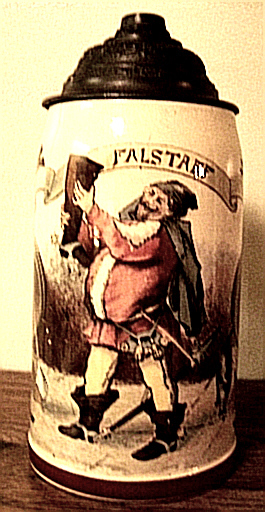
A V &B PUG Falstaff stein, No. 1909 (983), drinking from a boot!
For more on “drinking boots” , please see: http://www.steveonsteins.com/the-man-who-can-not-drink-his-boot-full-of-beer-is-not-a-true-bavarian-new-10-13-11
Falstaff appears in the following plays:
• Henry IV, part 1
• Henry IV, part 2
• The Merry Wives of Windsor
He is mentioned in Henry V but has no lines, nor is it directed that he appear on stage. However, many stage and film adaptations have seen it necessary to include Falstaff for the insight he provides into King Henry V’s character. The most notable examples in cinema are Laurence Olivier’s 1946 movie and Kenneth Branagh’s 1989 movie, both of which draw additional material from the Henry IV plays.
.
Here our man is holding a medieval glass beaker. [FWTD]
Orson Welles’s “Chimes at Midnight (1966)” compiles the two Henry IV plays into a single, condensed storyline, while adding a handful of scenes from Richard II and Henry V. The movie, also known as Falstaff, features Welles himself in the title role.
Falstaff (1893) is also the title of Giuseppe Verdi’s last opera, with a libretto by Arrigo Boito. It is mostly based upon The Merry Wives of Windsor Character.


.5 liter pottery incised stein. Ca. 1885-95. Maker unknown. An unusual rendition.
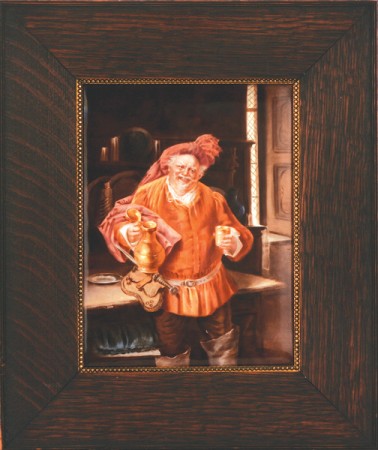
Painting on porcelain plaque. Marked T & W France, Limoges. Notice Falstaff when seen drinking, almost always has either a pewter server or a glass beaker in his hands.

Here as above, he is shown with both a pewter stein and a beaker. A 2.5 liter pottery relief stein of “The man.” Circa 1900. [RFA] Copied from the original oil, or a plaque such as just above.
What makes portly Sir John so entertaining? How is it, when his actions would repulse many in both a modern and medieval context, we find ourselves so attracted to this lying lub of lard? Speculation over the years have produced many possible answers, one no more likely than the next. Whether or not the Queen of England truly requested “Merry Wives” for herself because she was so fond of the “huge hill of flesh” (Henry IV pt I, Hal, Tavern Scene), most do find some sort of affectionate connection. Possibly his openness in his crimes, his lack of loyalty being so apparent– essentially his frankness (not so much honesty) in life and his grinning self-determination and self observance.
Origins:
There is abundant evidence that Falstaff was originally named ‘Oldcastle’ in the first performances of the play, although the name does not survive in any printed texts. The character was apparently based on Sir John Oldcastle, historically known to be Prince Hal’s companion. However, Oldcastle was unlike Falstaff in many ways; in particular, he was a Lollard who was executed for his opinions, and was revered by many Protestants as a martyr. During the first performances of 1 Henry IV, protests from Oldcastle’s descendants — the influential Cobham family — forced Shakespeare to change the name. The new name ‘Falstaff’ is derived from Shakespeare’s earlier play, Henry VI, part 1, in which there is a cowardly character based on the medieval knight Sir John Fastolf (who was also a Lollard). Changing a few letters gave Shakespeare the name by which his invention is known today. Worried, perhaps, that this change would not placate his detractors, Shakespeare made a direct comment on the situation, in the epilogue of 2 Henry IV:
“If you be not too much cloyed with fat meat, our humble author will continue the story, with Sir John in it, and make you merry with fair Katharine of France: where, for any thing I know, Falstaff shall die of a sweat, unless already a’ be killed with your hard opinions; for Oldcastle died a martyr, and this is not the man”
The character and deeds of Falstaff have very few similarities with those of his real-life eponyms. Shakespeare’s apparent desire to burlesque such heroes of early English Protestantism is one reason why some scholars believe he may have been a closet Catholic.
Source: http://encyclopedia.thefreedictionary.com/Falstaff

A large 2 liter Dumler & Breiden. #565, showing Falstaff and his side-kick, Bardolf. [RFA]
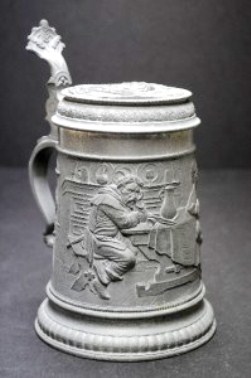
A very similar , but expanded scene to the one above – [probably copied the original art] showing the two drinking on a .5 liter pewter stein, dated 1890.
.
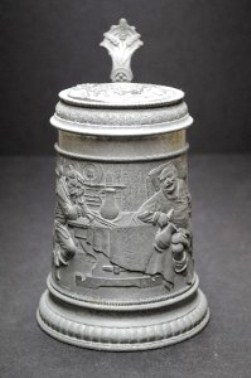
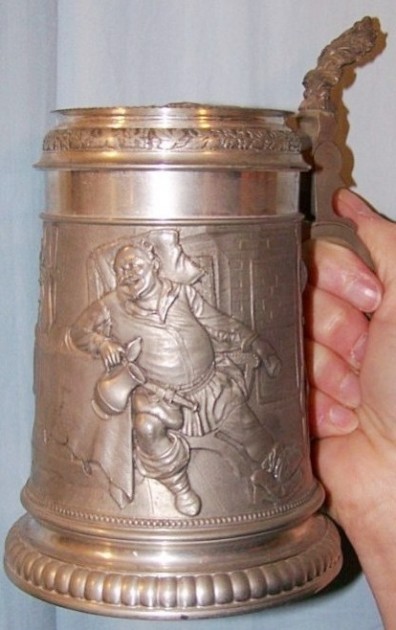
A newer version, re-issue, of the older (1900’s) cast pewter .5 liter stein shown above. There is no oxidation or wear what-so-ever on this piece.
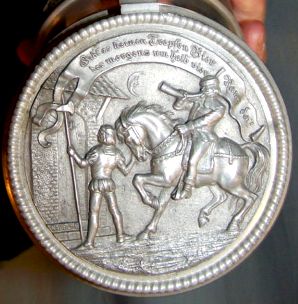
The relief pewter lid on the above.
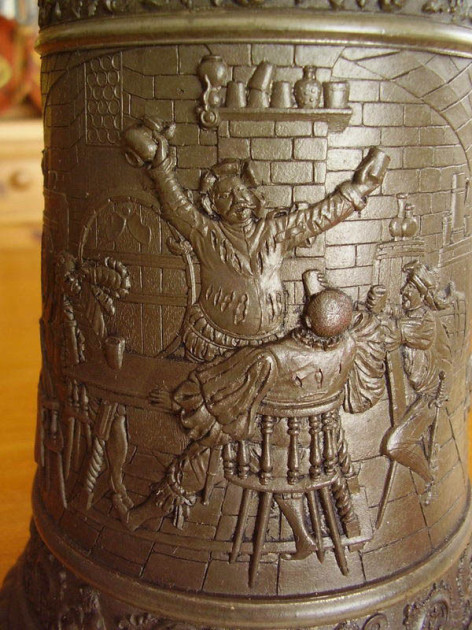
Another scene of Sir John that can be found on snother .5 liter pewter stein of the same vintage.
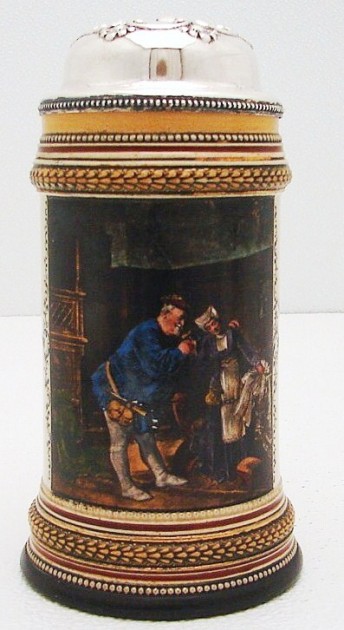
Falstaff on a .5 liter (what appears to be a Merkelbach and Wick) pottery, PUG stein. Circa 1890.
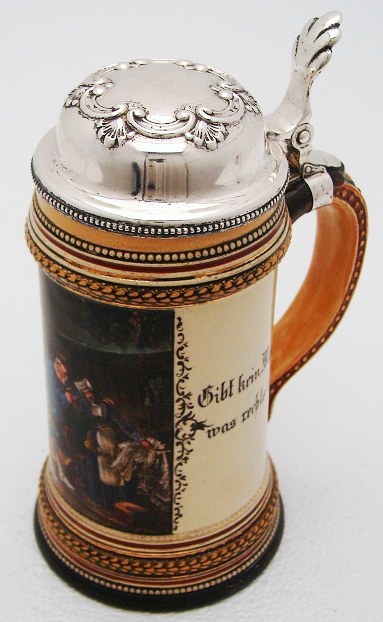
Detail of the silver lid.
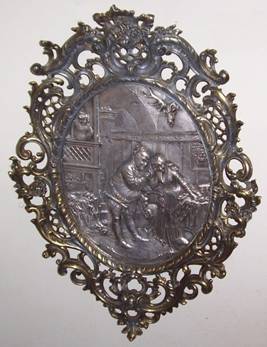
A pair of silvered copper wall plaques with German writing. Falstaff was very well thought of fictional character in old Germanyalso [Top] Depicted is a scene from the Shakespeare play “The Merry Wives of Windsor.” Sir John, with his usual calm, is pitching woo to Mrs. Ford. [Also see pug stein above.] [FWTD]
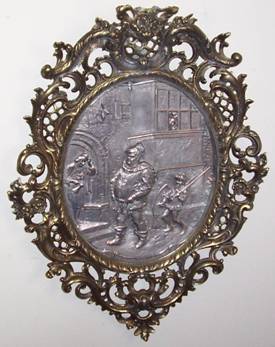
![Fallstaff [Q] Brass Trim Stein RFA - 6-13](http://www.steveonsteins.com/wp-content/uploads/2010/10/Fallstaff-Q-Brass-Trim-Stein-RFA-6-13.jpg)
Falstaff most likely. With brass mounts and feet. One liter. Ca. 1885. [RFA]
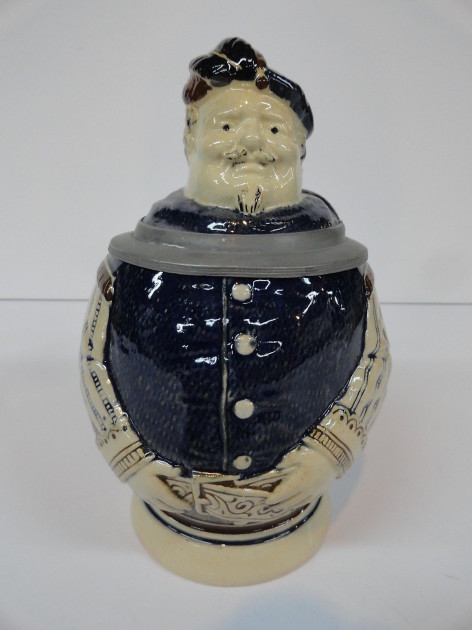
.
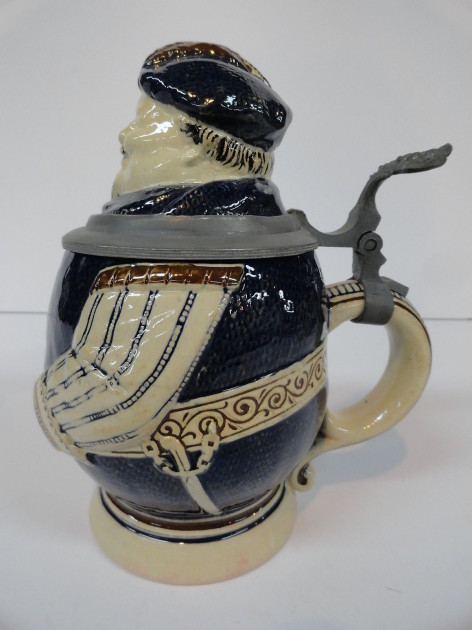
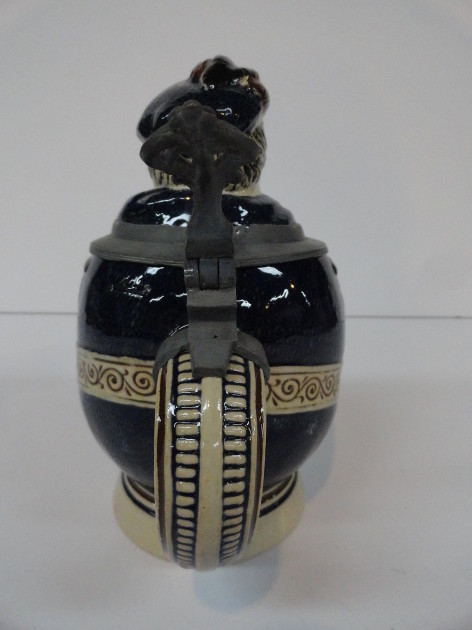
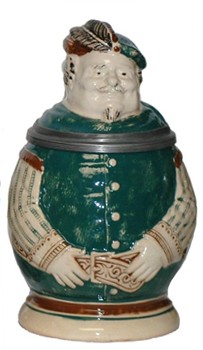 [RFA]
[RFA]
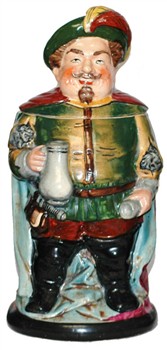 [TSACO]
[TSACO]
Above: Three pre -1900’s .5 liter pottery character steins that represent Sir John; even though none are named as such. These are usually called “Cavalier,” which is OF CORSE another SCI misnomer, as that is the French version of the word and not the German “Landsknecht .”
See: http://www.steveonsteins.com/lansquenets-on-beer-steins-etc-started-10-30-xing-as-i-go
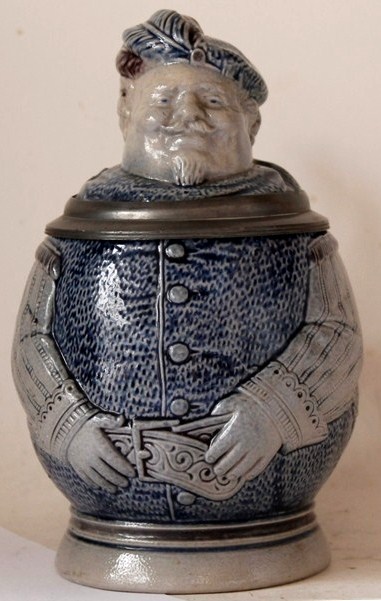
Falstaff by Merkelbach & Wick c.1890.
BELOW: Much NEWER Falstaff Brewing Company steins and other drinking vessels celebrating Sir. John .
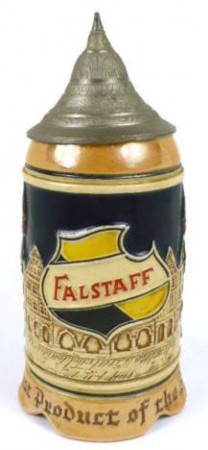
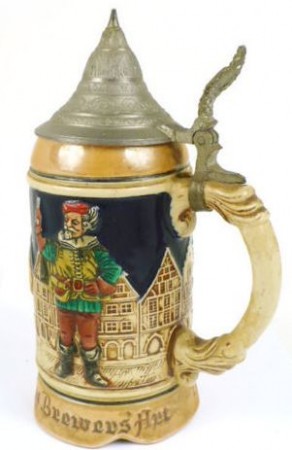
This .5 liter pottery relief stein came with a music box in the bottom.
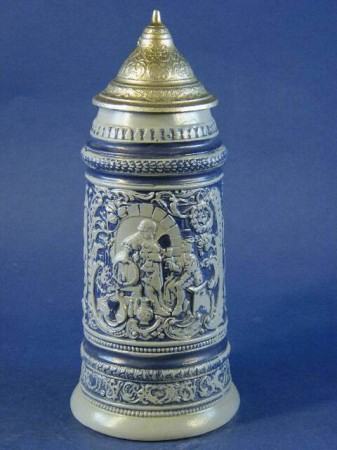
In 1971 Falstaff beer commissioned this replica of a turn of the century Westerwald stein. It is unfortunate but by that time the German government had outlawed the old salt-glazing methods due to the poisons it added into the air. With these new steins both the “orange peal” texture and the coloration leave much to be desired (not to mention that undetailed lid !)
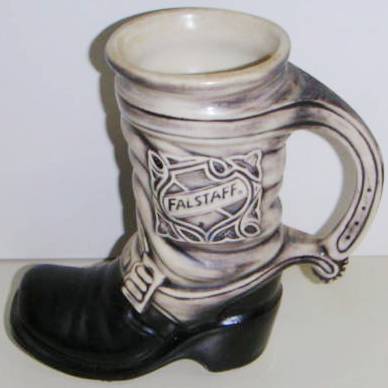
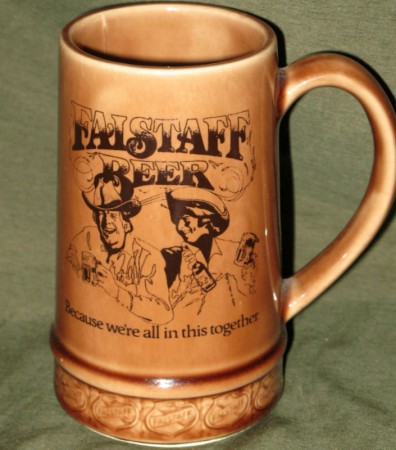
A Falstaff beer mug and a modern day version of the old drinking boot.
And speaking of Falstaff and beer!
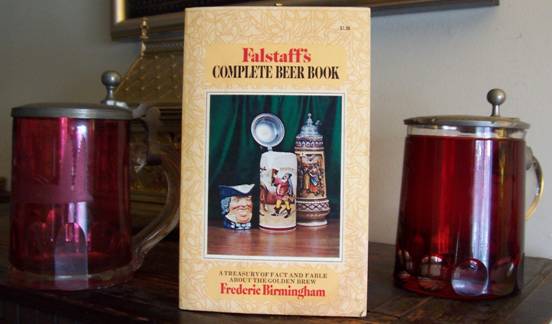
Another handy little paperback, published in 1970. Lots of great info on beer, but not too much on steins within the eight color photos in the center.
The chapters include:
[1] The Myth, Mystery and Meaning of beer.
[2] The Incredible Antiquity of Beer
[3] Beer comes to America.
[4] There is a tavern in the town. (very interesting to your editor)
[5] From Cup to Lip: (of most interest to us collectors)
[6] The Fine Art of Beer Quaffery and Cookery. [7] Stand Up and Drink a Toast
[8] Your PH. B. of Beer – the Facts of the Case.
[9] We Visit a Brewery
All in all a splendid little addition to one’s reference library – but hard to locate, even on the net!
[END – SOK – 46 – R5]
 Guy walks into a bar with jumper cables around his neck.
Guy walks into a bar with jumper cables around his neck.
Bartender says, “All right, I’ll let ya stay—but don’t start nuthin.”

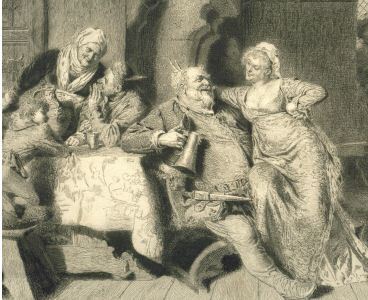
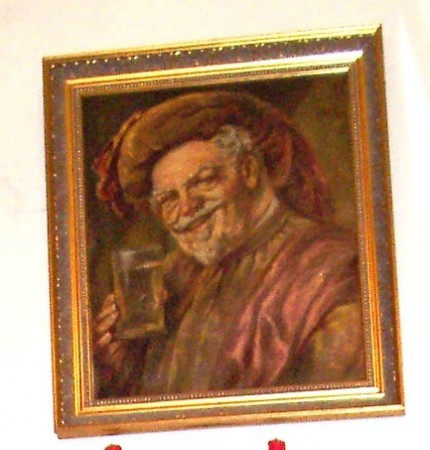
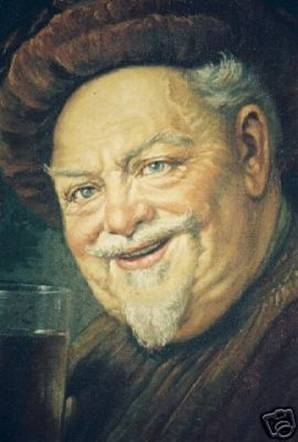
Leave a Reply